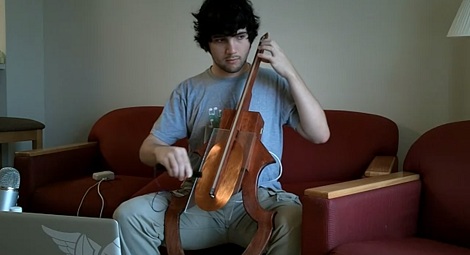Over the past few months, [Magnetovore] has been working on his magnetic cell project. It’s a very interesting instrument that seems right out of the electronic music explosion of the 1970s. Now, he’s ready to share his invention with the world, and we wouldn’t be surprised if we see this instrument being picked up by a few avant-garde musicians in the next few years.
Last September, we were introduced to [Magnetovore]’s magnetic cello. The original version used four ribbon sensors for each of the strings and had completely analog electronics, leaving us wondering why this cello wasn’t invented in the 70s. The new version of the cello keeps the analog electronics that sound remarkably like a real acoustic cello, but does away with three of the ribbon sensors. Now the cello has a single ribbon sensor being used as all four strings – to change which string is played, the musician just has to press a button on the ‘bow’.
There is a drawback to using only one ribbon sensor; it’s now impossible to play two strings simultaneously as on an acoustic cello. The electronics in [Magnetovore]’s original magnetic cello were monophonic anyway, so we’ll chalk this design change-up to reducing component cost.
After the break, you can check out a trio of very talented cellists playing [Magnetovore]’s magnetic cello. There’s the classic Pokemon Center theme, the Mario Bros. theme, as well a Bach minuet and a crazy improvisation showing off what the magnetic cello can do.
[youtube=http://www.youtube.com/watch?v=Wiveu9LSorU&w=470]
















Become one of the first owners of the Magnetic Cello. Demand will be high
Nice project, but I somehow doubt that ‘Demand will be high’.
Hmmmm… My sister plays the violin. Would the design be adaptable to other string instruments?
Having only one string usable at the time effectively cripples it as a cello.
Nice project otherwise.
it needs a better bow. its too annoying when the music gets quiter when the bow is farther away. it spoils the mood of the music
Bow and coil seem to be a rate of change=volume. As such the range is inches not the foot plus of a real bow, and is nonlinear. For some deep stuff look up MIT’s media lab with Ted Machover’s out of this world MII’s, with world class violin tryouts.
I will stick with my stick sized self sustaining dual string steel guitar. More on that soon, now I am connected.
+1 for the Pokemon Center tune.
I’d love to see this with an MOS SID Chip as an add-on for playing some wicked awesome chip jams.
As an amateur cellist, this does not sound much like a acoustic cello. With that said, I think that this is still really, really cool! Nice work.
Does it feel like a real Cello? Probably not. No, I’ve not tried it. But a real Cello I know. And having to switch strings in such an unatural way, well, it certainly will not prepar you to play a real Cello.
Even when watching the 1st performer – it is obvious he is a “Real Cellist”. His movements go way beyond what is (probably) necessary to play this electric Cello. Notice how he controls his bowing hand. All he (probably) needs to do is move it toward and away from the distance sensor. But he also changes it’s angle as if playing a real string instrument.
I don’t think this can be used as a substitute for a real string instrument. I think it would be difficult to improve your playing practicing on it. (There are electronic instuments which can be used to prepare you to play the real instrument. For example: http://lmgtfy.com/?q=electric+chanter).
Instead, I think this is a novel and interesting way to create music. It encoupases a familar (to some) interface that can be exploted to give yet another portal into the shear power of the common modern computer.
Sounds like 80s video games!